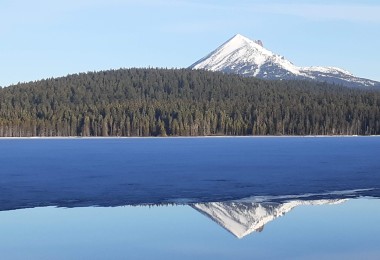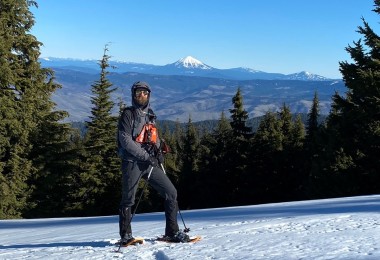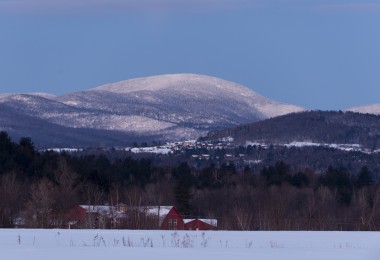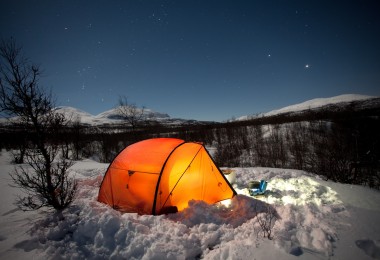When snow begins to blanket the area east of Portland, thousands of cross country skiers and snowmobilers head for their favorite winter playgrounds. For an increasing number of Oregon cold weather enthusiasts, however, snowshoes are becoming the preferred mode of transportation; sometimes for work, oftentimes for play. Snowshoes have come out of the backwoods and into the spotlight as people of all ages discover snowshoeing’s versatility and aerobic value, plus the fact that the activity is just plain fun.
Snowshoeing’s popularity in the Mt. Hood area and elsewhere is growing because the activity is easy to learn, offers an excellent low-impact workout, enables young and old alike to explore a variety of terrain together, and is available at relatively low cost.
Perhaps the best thing about snowshoeing is that you can go virtually anywhere. One can explore places you wouldn’t think of going in the warm weather months, such as swampy areas, or where there is considerable forest growth. Fallen trees and thick underbrush would stop a snowmobile in its tracks in the Mt. Hood National Forest, while cross-country skis perform best on groomed trails. Snowshoes, on the other hand, can go almost anywhere there is sufficient snow, just enough to get you above the growth. That’s the real beauty of the sport. There is no expensive equipment to purchase and no groomed trails—a person just goes out and bushwhacks.
The principle behind snowshoes, of course, is to increase the surface area of the foot, thereby allowing one’s body to “float” higher in the snow. The idea is not necessarily to always walk on top of a snow pack, but not sink too deep into it.
Snowshoeing is an age-old, yet still somewhat obscure sport. Funny that it even exists in the age of four-wheel-drive Hummers. Still, snowshoeing is often referred to, along with snowboarding, as the fastest-growing winter sport. But it’s not nearly as fast getting around on snowshoes as it is on a snowboard. And that is part of its charm.
Historians agree that people have been using snowshoes—wide pads designed to distribute body weight—for 6,000 years or so. Still, the actual time of “invention” may have been much earlier. Snowshoes found their way to what is now known as Oregon via Bering Strait Land Bridge migrations. Native Americans used them as far back as human events on the continent have been recorded.
The ancients trekked through snow on crude snowshoes—some more than seven feet long. The mega-sandals of yesteryear were designed in the manner of snow-negotiating animals. The “beavertail” has a rounded nose and the ends meet in a long tail; the “bearpaw” is short and broad with a round tail. Modern snowshoes used today to trek on Mt. Hood incorporate some of those principles, but are much lighter. They are no longer made of leather and wood, but rather urethane, steel and aluminum.
Snowshoeing became a popular recreational activity in Oregon in the 1920s, when outdoor clubs organized group snowshoeing “tramps” in the woods. As skiing attracted increasing numbers of people, snowshoeing’s popularity dwindled.
A resurgence began around 1990 with the development of snap-on bindings and durable lightweight shoes weighing less than two pounds. Recreational snowshoeing has caught on with Oregonians concerned about protecting the environment, with physical and spiritual well being, and with doing things together.
The first step in choosing the right snowshoe for use on Mt. Hood is to determine your needs, based on snow conditions, type of terrain, body weight and aesthetic desires. Heavy (wet) or icy snow allows for smaller snowshoes with grip-enhancing crampons. Drier snow, or fresh powder, calls for a larger-size snowshoe, which provides greater flotation.
Terrain also plays a role in deciding what type of snowshoe to purchase. For steep ascents, small-size ‘shoes with crampons provide better traction and greater maneuverability. In wide-open spaces, a larger-size snowshoe improves buoyancy.
Mastering the snowshoe walking technique on Mt. Hood takes a bit of trial and error. The first thing to learn is how to space the feet. Keep them far enough apart so the snowshoes don’t interfere with each other, but not so far apart that your stride is awkward or tiring. Before each step, lift the heel to a nearly vertical position, then bring the foot forward, swinging it out far enough to clear the other ankle. Lift the snowshoes only enough to clear the surface of the ground and each other.
If you lift your foot too high, you may fall down. But if you don’t lift high enough, you are likely to catch the tip in the snow and fall forward. Walk with your legs spread slightly farther apart than normal. Practice the bent-knee stride, keeping the toes pointed straight ahead. Once you have learned not to step on the other snowshoe, you are ready for a jaunt into the spectacular Mt. Hood wilderness.





